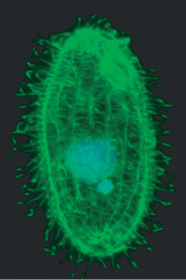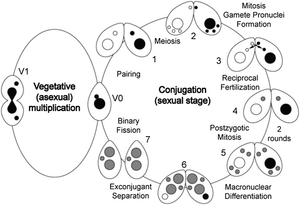Tetrahymena thermophila
Classification
Higher order taxa
Eukaryota; Chromalveolata; Ciliophora; Oligohymenophorea; Hymenostomatida; Tetrahymenidae
Species
Tetrahymena thermophila
Description and Significance
Tetrahymena thermophila is a unicellular eukaryote. The organism is about 30 x 50 µm. T. thermophila live in temperate freshwater environments.
Describe the appearance, habitat, etc. of the organism, and why you think it is important.
Genome Structure
T. thermophila contain both a micronucleus and a macronucleus. The micronucleus serves as the germ line, and contains the genetic information passed down in a sexual manner from one generation to the next. The micronucleus is diploid and contains five pairs of chromosomes. The macronucleus, in contrast, contains the genetic information which is transcribed, translated and passed onto daughter cells through asexual fission. The macronucleus contains 45 copies of 275 chromosomes derived from the fragmentation of the 10 micronuclear chromosomes, as well as 9000 copies of the rRNA gene. Both nuclei have been fully sequenced and scaffolds have been constructed [1]. Additionally the mitochondrial genome has been sequenced [2].
Cell Structure
During vegetative growth, ciliates reproduce by binary fission. In Tetrahymena, this involves a remarkable reorganization of the cortical cytoskeleton.
Metabolism
How it gains energy; what important molecules it produces.
Life Cycle
Ecology and Pathogenesis
Habitat; symbiosis; biogeochemical significance; contributions to environment.
If relevant, how does this organism cause disease? Human, animal, plant hosts? Virulence factors, as well as patient symptoms.
References
Author
Page authored by Hannah Pak and Luke Pryke, students of Prof. Jay Lennon at Indiana University.


